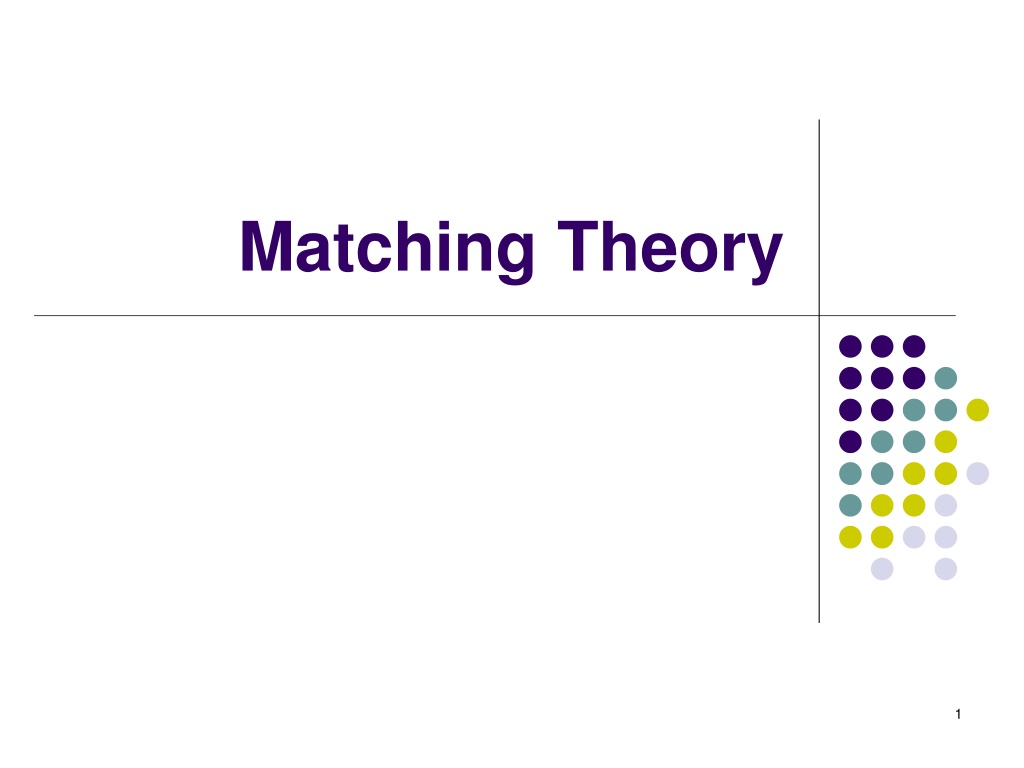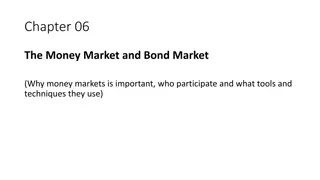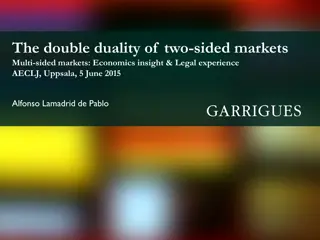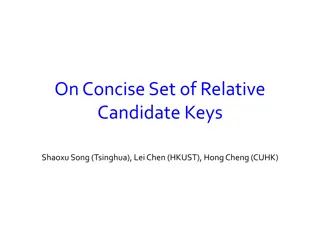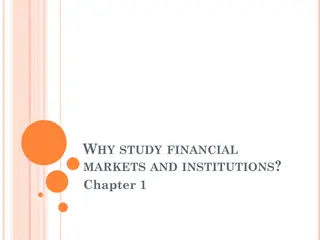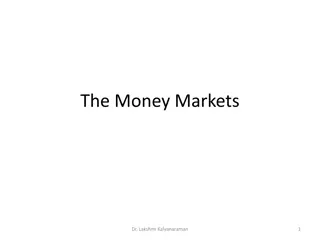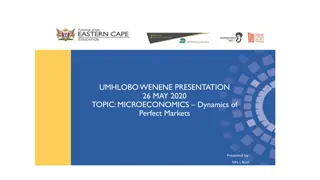Understanding Matching Theory in Two-Sided Markets
Matching theory explores the dynamics of two-sided markets where participants on both sides seek suitable matches without using money. Examples include marriage markets, medical residencies, school choice programs, and more. We delve into the marriage model, stable matching criteria, and the deferred acceptance algorithm to understand how matches are made and the concept of stability in pairings.
Download Presentation

Please find below an Image/Link to download the presentation.
The content on the website is provided AS IS for your information and personal use only. It may not be sold, licensed, or shared on other websites without obtaining consent from the author. Download presentation by click this link. If you encounter any issues during the download, it is possible that the publisher has removed the file from their server.
E N D
Presentation Transcript
Two-Sided Matching Statement of the problem Two sides of the market to be matched. Participants on both sides care about to whom they are matched. Money can t be used to determine the assignment. Examples Marriage & dating markets Medical residencies Fraternity/sorority rush Judicial clerkships School choice programs Military postings College admissions Job assignments in firms 2
Marriage Model Participants Set of men M, with typical man m M Set of women W, with typical woman w W. One-to-one matching: each man can be matched to one woman, and vice-versa. Preferences Each man has strict preferences over women, and vice versa. A woman w is acceptable to m if m prefers w to being unmatched. 4
Matching A matching is a set of pairs (m,w) such that each individual has one partner. If the match includes (m,m) then m is unmatched. A matching is stableif Every individual is matched with an acceptable partner. There is no man-woman pair, each of whom would prefer to match with each other rather than their assigned partner. If such a pair exists, they are a blocking pairand the match is unstable. 5
Example 1 Two men m,m and two women w,w m prefers w to w m prefers w to w w prefers m to m w prefers m to m Possible match: (m,w ) and (m ,w) Unique stable match: (m,w) and (m ,w ) 6
Example 2 Two men m,m and two women w,w m prefers w to w m prefers w to w w prefers m to m w prefers m to m Two stable matches {(m,w),(m ,w )} and {(m,w ),(m ,w)} First match is better for the men, second for the women. Is there always a stable match? How to find one? 7
Deferred Acceptance Men and women rank all potential partners Algorithm Each man proposes to highest woman on his list Women make a tentative match based on their preferred offer, and reject other offers, or all if none are acceptable. Each rejected man removes woman from his list, and makes a new offer. Continue until no more rejections or offers, at which point implement tentative matches. This is the man-proposing version of the algorithm; there is also a woman proposing version. 8
Stable matchings exist Theorem. The outcome of the DA algorithm is a stable one-to-one matching (so a stable match exists). Proof. Algorithm must end in a finite number of rounds. Suppose m, w are matched, but m prefers w . At some point, m proposed to w and was rejected. At that point, w preferred her tentative match to m. As algorithm goes forward, w can only do better. So w prefers her final match to m. Therefore, there are NO BLOCKING PAIRS. 10
Example Preferences of men and women m1: w1 > w2 > w3 w1: m2 > m3 > m1 m2: w3 > w2 > w1 w2: m2 > m3 > m1 m3: w3 > w1 > w2 w3: m2 > m1 > m3 Find a stable matching. 11
Aside: the roommate problem Suppose a group of students are to be matched to roommates, two in each room. Example with four students A prefers B>C>D B prefers C>A>D C prefers A>B>D No stable match exists: whoever is paired with D wants to change and can find a willing partner. So stability in matching markets is not a given, even if each match involves just two people. 12
Why stability? Stability seems to explain at least in part why some mechanisms have stayed in use. If a market results in stable outcomes, there is no incentive for re-contracting. We will see in the next class that the clearinghouses using the Deferred Acceptance algorithm have fared pretty well. Other clearinghouses that use unstable matching mechanisms seem to have failed more often. But does one need an organized clearinghouse? 13
Decentralized market What if there is no clearinghouse? Men make offers to women Women consider their offers, perhaps some accept and some reject. Men make further offers, etc.. What kind of problems can arise? Maybe w holds m s offer for a long time, and then rejects it, but only after market has cleared. Maybe m makes exploding offer to w and she has to decide before knowing her other options. No guarantee the market will be orderly 14
Example: clinical psychology Clinical psychologists are employed as interns after they complete their doctoral degrees. About 500 sites offer 2,000 positions each year. Clears with one day market. On selection day, market opens at 9 am, closes at 4 pm. While market is open, offers will be made and accepted according to a version of the DA algorithm, but a human version where people make phone calls. Offers can be accepted early and programs often ask students to indicate in advance their willingness to accept an offer. (You ll see why.) Roth and Xing (1994) describe a site visit in 1993. 15
Example: clinical psychology Program had 5 positions, 71 applicants, 29 interviews, Directors had ranked 20, and knew 6 would say yes if asked. Their strategy: don t tie up offers with people who will hold them . Timeline on selection day At 9:00, calls placed to candidates 1,2,3,5,12 ---- 3,5,12 accept. Candidate 1 reached at 9.05, holds until 9.13, rejects. In the interim, candidate 8 calls, says she will accept. When 1 rejects, call placed to 8, who accepts. While call is in progress, 2 calls to reject. Call placed to 10 (who d indicated acceptance), accepts at 9.21. By 9.35, remaining candidates informed of non-offer. 16
Optimal stable matchings A stable matching is man-optimal if every man prefers his partner to any partner he could possibly have in a stable matching. Theorem. The man-proposing DA algorithm results in a man-optimal stable matching. This matching is also woman-pessimal (each woman gets worst outcome in any stable matching). Note: the same result holds for woman-proposing DA with everything flipped. 17
Proof Say that w is possiblefor m if (m,w) in some stable matching. Show by induction that no man is ever rejected by a woman who is possible for him. Suppose this is the case through round n. Suppose at round n+1, woman w rejects m in favor of m . Note: this means m made an offer to w in round n+1 and hence all the women m prefers to w (who he made prior offers to and who rejected him) must be impossible for him, by the inductive hypothesis. Claim: w must be impossible for m. Suppose we try to construct a stable matching that pairs (m,w). We need to put m with someone, but we can t put him with a woman he prefers to w (they are impossible for him), and if we put him with someone less preferred, he and w will block. So in no round is a man rejected by a possible woman. 18
Stability vs. Pareto Efficiency The man-optimal stable match is best for men given stability, but may not be Pareto efficient for the men. Example: men m1, m2, m3; women w1, w2 m1: w1 > w2 w1: m2 > m3 > m1 m2: w2 > w1 w2: m1 > m3 > m2 m3: w1 > w2 Stable match is (m1, w2), (m2, w1). But men would be better off if m1, m2 swap wives! Why is this? Stability respects women s preferences as well as men s. The stability vs Pareto efficiency tension will be important when we discuss school choice. 19
Rural Hospitals Theorem Theorem. The set of men and women who are unmatched is the same in all stable matchings. Why rural hospitals ? DA is used to assign doctors to hospitals some hospitals wondered if changing the algorithm would help them fill positions. 20
Proof of RH Theorem Let M,W be the sets of men and women matched in the man-optimal stable matching (which is also woman-pessimal). Let M ,W be the sets of men and women matched in some other stable matching. Any man in M must also be matched in the man-optimal stable matching, so M M and also |M | |M|. Any woman matched in the woman-pessimal stable matching must also be in W , so W W and also |W| |W |. In any stable matching, the number of matched men equals the number of matched women, so |M|=|W| and |M |=|W |. Therefore |M | = |M| = |W| = |W |. And so we must have M=M and W=W . 21
Strategic Behavior The DA algorithm asks participants to report their preferences. Should they report truthfully or be strategic? Definitions: A matching mechanism is a mechanism that maps reported preferences into an assignment. A mechanism is strategy-proof if for each participant it is always optimal to be truthful. 22
DA is strategy-proof for men Theorem (Dubins and Freedman; Roth). The men proposing deferred acceptance algorithm is strategy-proof for the men. Proof. Fix the reports of all women and all but one man. Show that whatever report the man m considers making, there will be a chain of (weak) improvements leading to a truthful report. 23
Proof Suppose m is considering making a report that, fixing the reports of others, will lead to a match x where he gets w. The following changes improve his outcome Reporting that w is his only acceptable woman. DA will still result in him getting w as if he sat out the rounds before he otherwise would have asked w. Reporting honestly, but truncating at w. Can t hurt to ask women he likes better he might get one and if not, he can still get w even asking at the end. Reporting honestly with no truncation. This won t affect DA relative to above strategy. 24
DA not strategy-proof for women Example (two men, two women) m prefers w to w m prefers w to w w prefers m to m w prefers m to m Under man-proposing DA algorithm If everyone reports truthfullly: (m,w),(m ,w ) If w reports that m is unacceptable, the outcome is instead (m,w ),(m ,w) --- better for w! 25
Strategic behavior The example on the previous slide can be used to establish the following result. Theorem. There is no matching mechanism that is strategy-proof and always generates stable outcomes given reported preferences. Both versions of DA lead to stable matches, so neither version is strategy-proof for all participants! 26
How many stable matchings? Evidently, the incentives and scope for manipulation depend on whether preferences are such that there are many stable matchings. If there is a unique stable match given true preferences, there is no incentive to manipulate if others are reporting truthfully. When might we have a unique stable match? Ex: if all women rank men the same, or vice-versa. In large markets? We ll come back to this later. 27
Summary Marriage model captures generic situation in which Participants on two sides must be matched one-to-one. Participants care about who they get matched with. Stability is a desirable outcome in this problem. Deferred acceptance algorithm finds a stable match Man-proposing version also finds stable match that is optimal for the men, and induces men to be truthful. Women may have some incentive to manipulate the algorithm by truncation, if they can identify an opportunity. Next time we will start to look at applications. 28
